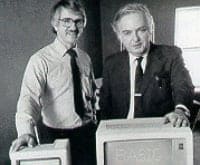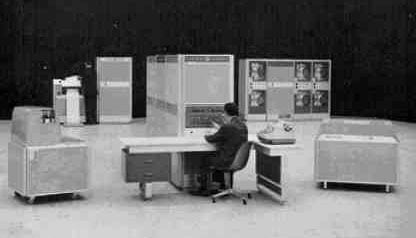Complete History of the World Easy to Learn Program

Before Java, Python, and other programming languages, there was the BASIC programming language. It is important to note that programming languages existed before computers were developed. It was a way for users to give machines a set of commands for specific functions. BASIC or Beginner's All-Purpose Symbolic Instruction Code is a high-level programming language designed to provide easy access to computer facilities.
Its developers John George Kemeny, the Dartmouth College Mathematics Department chairman and his colleague Thomas Eugene Kurtz wanted to create a simplified system that would enable students in non-scientific fields to use computers.

7 Facts about BASIC Programming Language
- The first version of BASIC was released on May 1, 1964.
- The creation of BASIC gave way to what was the first real form of personal computer
- The BASIC language was initially based on FORTRAN II, with some influences from ALGOL 60 and additions to make it suitable for time-sharing systems like DTSS.
- BASIC was the first product sold by Microsoft Corporation, and also the first significant case of software piracy – It was copied widely even before Microsoft made it available (Bill Gates lost track of a copy on paper tape during a computer show)
- The first Basic considered a full language implemented on a microprocessor was Li Chen Wang's "Tiny Basic," which appeared in Dr. Dobbs.
- The developers—John George Kemeny and Thomas Eugene Kurtz, never copyrighted BASIC language, which led to alterations and variations. They later registered a company to develop true BASIC, which met all the ANSI and ISO standards.
- As microcomputers with advanced programming language features came to the market in the 1990s, BASICs popularity began to decline gradually.
What is BASIC Programming Language: Explained
BASIC is one of the simplest high-level programming languages that can be easily learned. Its developers focused on creating a language that novice programmers and students could use. BASIC became simple and easy to use with commands similar to English for beginners. When computers were first developed, they were so complex to operate, and only mathematicians and scientists could program them.
To open up computer programming to more people, a simplified programming language was necessary—and that's how BASIC came into existence. It became so popular after its creation in the 1960s that most of the earliest personal computers utilized it extensively. Over time, BASIC has been widely imitated and altered, and it is currently most well-known as Visual Basic.
How to Use BASIC Programming Language
BASIC was initially made available on 11 Teletype machines. BASIC originally used letters at the beginning of every instruction to give the computer the order of processing a set of instructions. Its first version had 14 commands with straightforward names and easy to understand syntax:
- PRINT output text and numbers to the Teletype (and, later on, displayed it on the screens of time-sharing terminals and PCs);
- LET told the computer to perform calculations to solve a problem and assign the result to a variable, in statements such as LET C = (A*2.5) +B;
- IF and THEN were crucial in letting the program determine if a statement was true, vital for anything involving decision-making;
- GOTO let a program branch or loop to another numbered line within itself;
- END, which was required in Dartmouth BASIC, told the computer that it had reached the program's conclusion.
The INPUT command also allowed a BASIC program to accept alphanumeric characters typed in by a user. The INPUT command was not among the initial 14. It was introduced in the third revision of BASIC language in 1966 and was very significant in enabling users to write more interactive programs.
Without INPUT, BASIC was mainly used to do simple simulations and solve math problems. With the introduction of INPUT, BASIC could do almost everything, including playing games.
With all these commands, you could write a fairly sophisticated program, solve a research problem, play a game, and complete any task you could think of in an easy way.
Whereas the first BASIC version was more text-based, modern BASIC programming allows users to design programs visually using a graphical user interface. Newer BASIC developments also support diverse data types like integers, strings, and arrays for storing variables and other data.
BASIC is a very powerful language as a tool for the novice programmer. BASIC allows for a wide range of applications, and it has many versions. For example, to write a program to print the phrase "Hello World" infinitely, one has to enter only 2 lines of code:
10 PRINT "Hello World!"
20 GOTO 10
Most first-generation BASIC versions, such as GW-BASIC and MSX BASIC, supported arrays, loop cycles, and simple data types. The following example is written for GW-BASIC, but will work in most versions of BASIC with slight changes:
10 INPUT "What is your name: "; U$
20 PRINT "Hello "; U$
30 INPUT "How many stars do you want: "; N
40 S$ = ""
50 FOR I = 1 TO N
60 S$ = S$ + "*"
70 NEXT I
80 PRINT S$
90 INPUT "Do you want more stars? "; A$
100 IF LEN(A$) = 0 THEN GOTO 90
110 A$ = LEFT$(A$, 1)
120 IF A$ = "Y" OR A$ = "y" THEN GOTO 30
130 PRINT "Goodbye "; U$
140 END
The resulting dialog might resemble:
What is your name: Mike
Hello Mike
How many stars do you want: 7
*******
Do you want more stars? yes
How many stars do you want: 3
***
Do you want more stars? no
Goodbye Mike
How to Learn BASIC Programming Language
With its wide variety of applications in many languages, learning BASIC Programming Language can be a good way of increasing your computer programming capabilities.
Fortunately, BASIC is easy to learn. The syntax is straightforward and simple. Even for those who have never needed to use objects in Java, BASIC is easy to pick up as all you really need to learn are a few simple rules. There are many free BASIC tutorials online and numerous books that take a deep dive into the subject. Here are a few websites that offer excellent learning materials for BASIC Programming Language:
- http://www.hoist-point.com/applesoft_basic_tutorial.htm
- https://freebasic.net/wiki/CommunityTutorials
- https://www.instructables.com/BASIC-programming/
- https://users.freebasic-portal.de/rdc/tutorials.html
The Difference Between BASIC Programming Language and Java
While all the programming languages are almost similar, certain things distinguish them.
- BASIC is a high-level easy-to-use programming language whose original version was created by John G. Kemeny and Thomas E. Kurtz. On the other hand, Java is a high-level, object-oriented language developed by Sun Microsystem and is currently owned by Oracle.
- BASIC is case sensitive while Java is not.
- BASIC is a dependent platform that can run on different versions of windows and processors, while Java is independent and can run on any operating system.
- Whereas Basic uses CRL (Common Running Language) to execute programs, Java uses (JVM)Java Virtual Machine at runtime to execute programs.
- BASIC language can be learned with ease, making it convenient for beginners. On the other hand, Java is complicated and requires basic programming knowledge.
- BASIC requires a Windows license, while Java is an open-source framework.
- It is easy to locate errors in BASIC because it is translated and has simple data structures. Java does not have the common syntax for querying any data source, making it challenging to define queries.
BASIC Programming Language Release History
The BASIC programming language was first released on May 1, 1964. This was after John George Kemeny (born as János György Kemény) (1926–1992), chairman of the Dartmouth College Mathematics Department, and his colleague Thomas Eugene Kurtz (b. 1928) submitted a grant to NSF for the development of a new time-sharing system, intending to provide easy access to computing facilities for all members of the college. Its implementation began in 1963 by a student team under the direction of Kemeny and Kurtz.
On May 1, 1964, the system, named Dartmouth Time-Sharing System, or DTSS for short, was initially implemented to run on a GE-200 series computer (GE-200 series was a family of small mainframe computers of the 1960s, manufactured by General Electric) began operations and remained in operation until the end of 1999.

Having removed one of the main barriers to computer use, Kurtz and Kemeny went on to simplify the user interface so that a student could essentially learn enough to use the system in no time. But writing programs in the computer languages then in use was quite challenging. Kurtz initially tried to simplify specific existing languages, namely Algol and FORTRAN, but eventually decided with Kemeny that a new, simplified programming language was needed. The resulting programming language was called BASIC (an acronym for Beginner's All-purpose Symbolic Instruction Code) and has become the most widely used language in the world.
Initially, BASIC concentrated on supporting straightforward mathematical work, with matrix arithmetic support from its initial implementation as a batch language and full string functionality being added by 1965.
When other dialects of BASIC language began emerging a few years after its release, the original BASIC dialect was named Dartmouth BASIC. When minicomputers were introduced, they had a little memory that could not support compilers. BASIC was more of an interpreter than a compiler in this case. The Golden Era of BASIC came with introducing the first microcomputers in the mid-1970s. BASIC had the advantage that it was fairly well known to the young designers and computer hobbyists who took an interest in microcomputers.
In 1983, Kemeny, Kurtz along with several others formedTrue BASIC, Inc., with the intention of creating a personal computer version of BASIC for educational purposes.
BASIC Programming Language: End of Development
BASIC achieved massive success in the years following its invention. A triumphant report by Kemeny and Kurtz indicated that 80 percent of the three incoming first-year classes who had arrived since BASIC's invention–would have learned about computers by writing and debugging their programs.
"Anyone who tries to convince a Dartmouth undergraduate either that computers are to be feared or that they are of little use will be met with well-founded scorn," said part of the report. However, as microcomputers entered the market, BASIC's popularity began diminishing. The original BASIC remained in operation until 1999. Since then, there have been several alterations and variations, most of which build on the BASIC concept to advance programming.
BASIC Programming Language: History, Origin, and More FAQs (Frequently Asked Questions)
What is BASIC?
BASIC is one of the simplest high-level programming languages that can be easily learned. Its developers focused on creating a language that novice programmers and students could use. With commands similar to English, BASIC became simple and easy to use for beginners.
When was BASIC Programming Language created?
The BASIC programming language was first released on May 1, 1964
Who invented the BASIC programming language?
The BASIC programming language was invented by John Kemeny and Thomas Kurtz.
Is BASIC still used today?
Yes, BASIC continues to be widely used because it is easy to learn and is supported by most operating systems. It also forms the basic framework to learn other programming languages with advanced features.
What is BASIC used for?
BASIC simplifies communication between the user and the computer by allowing the programmer to access more consolidated data and actions. Its emphasis on symbols makes it more convenient for beginners.
larsenrinnaligge50.blogspot.com
Source: https://history-computer.com/basic-programming-language-guide/
0 Response to "Complete History of the World Easy to Learn Program"
Post a Comment